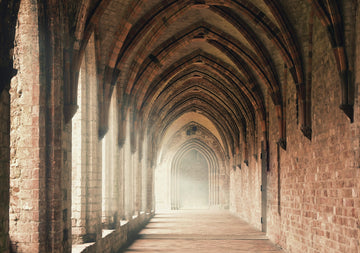History of Monastic Design: Monasteries, Art and Architecture
In the 4th century, monastic life developed in the deserts of Egypt and Syria, when hermits sought community life.
A hermit is a person who consciously chooses to live in seclusion, usually for religious reasons. They often retreat to isolated places such as deserts, forests or mountains to live in silence. Their goal is to devote themselves more intensely to prayer and asceticism, far from the distractions of society.
The first monks lived as hermits, and Anthony the Great is considered one of the most important founders of monasticism. Later, monastic communities emerged in which the monks lived according to common rules.
Pachomius played a decisive role, founding the first coenobitic monastery around 321, which was based on communal prayer, work and the sharing of goods. The monastic movement spread rapidly, also through writings such as the Vita Antonii, and found further support in the West from Augustine of Hippo.
These early communities laid the foundation for a way of life that was later shaped by the Rule of Saint Benedict of Nursia in the 6th century. The Rule of Benedict became the basis of many European monasteries.
Since the 4th century, monastic design principles have shaped monastic life and reflected the spiritual values of the monks. Here is a summary of the most important principles of monasticism:
Spirituality and community : Monasteries are places of prayer and community. The central focus is on liturgy, often at the heart of the monastery – the church. The architecture is designed to support monastic life and encourage connection with God.
Functional architecture : The monastery's floor plan follows a structured pattern that includes spaces for prayer, work and community life. The arrangement of the refectory (dining room), dormitory (dormitory) and work areas promotes harmonious coexistence and spiritual activities.
Simplicity and symbolism : Monastic architecture emphasizes modesty and simplicity to minimize worldly distractions. Romanesque monasteries are often characterized by massive walls and small windows, while Gothic monasteries symbolize grandeur with high vaults and plenty of light.
Natural materials : The use of stone, wood and other natural materials contributes to the spiritual atmosphere and reflects the principle of modesty and sustainability.
Art and religious education : Art, such as frescoes and sculptures, plays an important role in monastic life. It serves not only as decoration, but also for religious education and the visualization of spiritual themes.
These principles aim to create an environment conducive to both contemplation and practical living.
One of the most important early monasteries was Monte Cassino, which Benedict himself founded and which served as a model for many other monasteries. In the 10th century, the Cluniac Reform brought new impetus to monastic life by demanding strict adherence to the Rule of Benedict.







